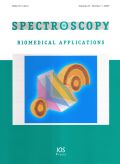Authors: Gierlinger, Notburga | Schwanninger, Manfred
Article Type:
Research Article
Abstract:
To gain a better understanding on structure, chemical composition and properties of plant cells, tissues and organs several microscopic, chemical and physical methods have been applied during the last years. However, a knowledge gap exists about the location, quantity and structural arrangement of molecules in the native sample or what happens on the molecular level when samples are chemically or mechanically treated or how they respond to mechanical stress. These questions need to be answered to optimise utilization of plants in food industry and pharmacy and to understand structure-function relationships of plant cells to learn from natures unique. Advances in
…combining microscopy with Raman spectroscopy have tackled this problem in a non-invasive way and provide chemical and structural information in situ without any staining or complicated sample preparation. In this review the different Raman techniques (e.g. near infrared Fourier Transform Raman spectroscopy (NIR-FT), resonance Raman spectroscopy, surface-enhanced Raman spectroscopy) are briefly described before approaches in plant science are summarised. Investigations on structural cell wall components, valuable plant substances, metabolites and inorganic substances are included with emphasis on Raman imaging. The introduction of the NIR-FT-Raman technique led to many applications on green plant material by eliminating the problem of sample fluorescence. For mapping and imaging of whole plant organs (seeds, fruits, leaves) the lateral resolution (~10 μm) of the NIR-FT technique is adequate, whereas for investigations on the lower hierarchical level of cells and cell walls the high resolution gained with a visible laser based system is needed. Examples on high resolution Raman imaging are given on wood cells, showing that changes in chemistry and orientation can be followed within and between different cell wall layers having dimensions smaller than 1 μm. In addition imaging the distribution of amorphous silica is shown on horsetail tissue, including an area scan from a cross section as well as a depth profiling within a silica rich knob of the outer stem wall.
Show more
Keywords: Cellulose, cell walls, chemotaxonomy, crystallinity, hemicelluloses, inorganic substances, lignin, micromechanical studies, minerals, molecular stress, plant fibres, plant metabolites, silica, terpenes
Citation: Spectroscopy,
vol. 21, no. 2, pp. 69-89, 2007
Price: EUR 27.50





